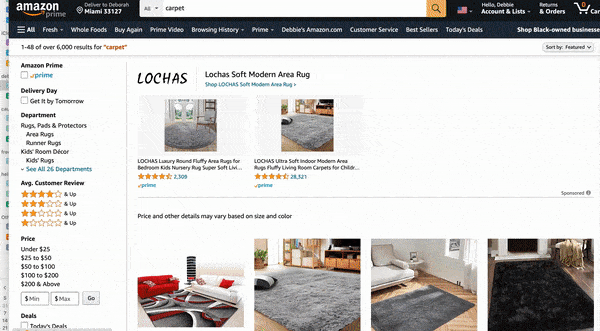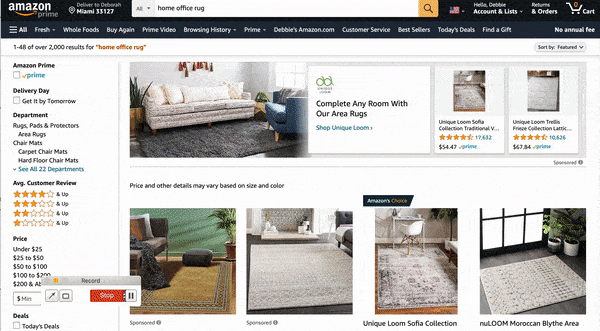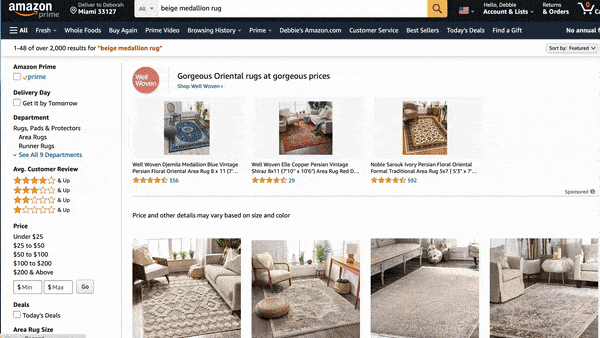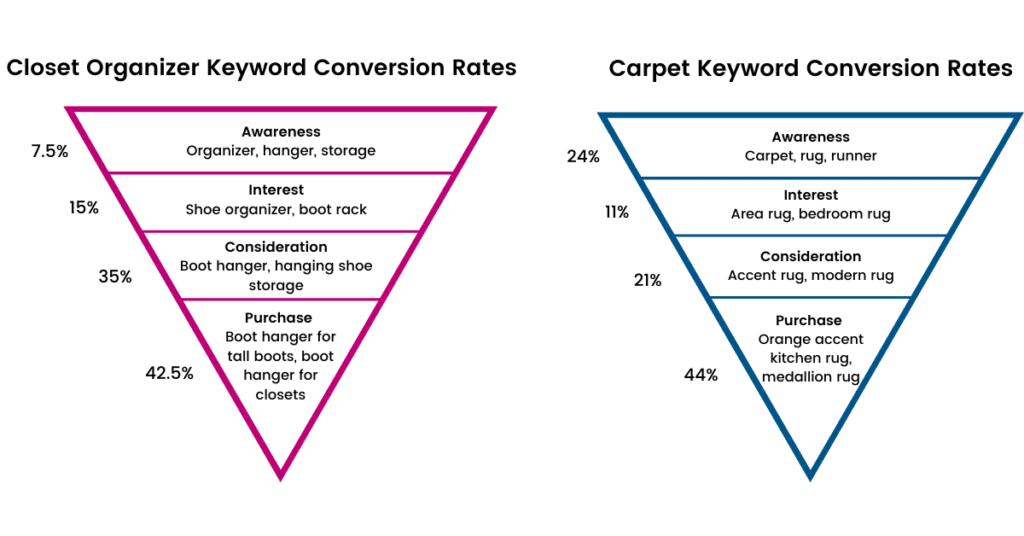Keywords play a pivotal role in customers looking to discover new eCommerce products throughout every stage of the buyer’s journey on Amazon. In a sea of 12 million products on Amazon, how do eCommerce companies looking to increase visibility and conversions get discovered by their target audience?
Let’s dive into why casting a wide net of keywords in the initial stages is essential for product discovery and purchase on Amazon, one of the world’s most robust search engines on the planet for products.
How people use keywords when searching for products at every stage of the buying funnel
At the top of the funnel, also known as the awareness stage, all the way down to the consideration, evaluation, and purchase stages, people search for a solution to a problem that they are interested in solving.
Let’s explore a scenario where a shopper navigates through the buying funnel as they look to find a product on Amazon.
A scenario of a buyer persona on Amazon’s search engine: Discovering and purchasing a carpet
Ella recently started to notice that the cement floor in her new home office is cold during a cool day in October. She feels distracted and is worried about optimal productivity as the winter months progress.
The discovery process begins with finding a solution. Using Amazon’s search box, Ella AKA “the carpet seeker” might type in a singular word in the search query like, “carpet.”

It’s broad enough and would result in a lot of different options as she is looking to discover what the best solution might be. Ella may also use multiple-word keyword phrases such as “home office rug” or “area rug.”

Or she could get very specific in her search query and ask for the color that would compliment the room along with a keyword or string of keywords that would be solutions-based such as, “beige medallion rug.”

All of these search queries are represented by the person’s intent to purchase and where they are at in the buying funnel. Only focusing on one aspect of these search terms or keywords represented in the area of the buying funnel could leave a lot of money on the table. Some companies might just focus on the specific keywords or keyword phrases that they think best define their products and therefore would capture buyers in the purchase phase.
However, as we can see in this chart, conversions are captured at every single stage in the buyer’s journey and all keywords from broad to long tail should be added and tested. Does she want a rug? Or simply a carpet? Or maybe she would prefer a few accent rugs to cover some of the cement?
There are multiple pathways the user can go down to discover the solution to the problem they are looking to solve through keyword searches. As a company offering those solutions, the goal is to show up on the search engine results pages for multiple relevant keywords to be in the arena for capturing the sale while the user is considering or evaluating the purchase.
If we do a side-by-side comparison of the carpet company with the closet organization company, we learn that both scenarios in conversions play out vastly differently at every stage in the buyer’s journey.

Step 1: Exact and broad matching keywords
Flooring or carpet solutions companies would want to show up for a wide range of keywords that answer each potential pathway of the buyer’s intent to purchase. Flooring or carpet companies would want to use an exact match keyword list, along with keyword lists that are longtail in nature and capture everything from the problem down to the solution, and everything in between.
As a company looking for these buyers, it’s imperative to broadly match your keywords to these search queries as well as offer longtail keywords for those questions that could be asked in the discovery process. Using a combination of exact and broad match keywords covers the spectrum of searches for potential buyers to find your products.
In conclusion: Never make assumptions about which keywords will drive sales. Always test far and wide and deep, and let your buyers tell you how they find your products on Amazon.
Step 2: Keeping it relevant + negating keywords
The relevancy of keywords must also be considered when setting up and managing Amazon keyword campaigns. Campaigns should include negative keywords, which are keywords to not use in the campaign, to ensure that products are not showing up for irrelevant results on the Amazon SERP (Search Engine Results Page).
The goal here is to gain visibility, increase engagement, and drive sales. Showing up for irrelevant keywords will cost you both money and sales, and negatively impact how Amazon scores the business for underperforming words.
Step 3: Follow your keyword path instead of copying your competitors
It’s more important in the beginning to cast as wide of a net as possible on your search words and then harvest out the words that are driving results. Luckily, Amazon offers a thorough search terms report which gives eCommerce companies insights into which search terms your customers have entered.
Without casting a wide net of search terms, brands won’t benefit from this visibility and therefore will not do the most thorough job of harvesting keywords. Knowing search volume is important in determining what keywords cost and what demand is available for those search queries.
Unfortunately, Amazon stopped offering sellers keyword volume transparency. Only copying what your competitors are doing isn’t the best strategy because what works best for them, isn’t necessarily what will drive the best results for you. Having a solution that helps prune out the myriad of keywords will ensure that you are optimizing for results instead of the volume of impressions.
Step 4: Manual vs. automate keyword bid and optimization
So how do you do this all at scale? They say time is money for a reason. Optimizing for conversion, lower ACoS, and increasing your profit is the end goal, but you first have to test to see what works best for your product line. With millions of sellers on Amazon and hundreds or thousands of competitors potentially for your products alone, it’s fierce in the landscape of capturing conversions on this massive marketplace.
If your business has less than five SKU’s, doing this process manually could be easier to manage without automation, however being able to automate the process no matter how large your campaign is can play a crucial role in optimizing for more granular insights and increased ROI. Having the ability to gain a faster learning curve by automating the process of keywords across multiple SKUs means more money in your pocket.
The benefits of harvesting keywords from your automated campaigns, with both phrase and broad keywords, and leveraging the top-performing keywords into your manual campaigns allows teams to control time and accuracy for greater optimization of ACoS (advertising cost of sale).
This offers teams granular flexibility and fluidity by saving money on wasted clicks and visibility on what is working. Plus, let’s face it, humans make errors and those errors can be quite costly. Unless you have someone around the clock checking the data, monitoring and adjusting keywords, bids, and harvesting keywords 24/7, it’s a labor-intensive process that has flaws.
Step 5: Finding the right solution
There are multiple reasons why businesses succeed on Amazon. Just behind having a stellar product line, running the most optimal keyword PPC campaign is high on the list. If we have learned nothing else over the past year in eCommerce and the ever-changing world, sellers need more flexibility to adjust and change campaigns as demands in the market shift.
Trellis automates all of the steps outlined in this article by using Amazon advertising keyword best practices with top-notch advertising optimization technology that can drive sales at a lower ACoS. Download Trellis’ Advanced Amazon PPC Strategy Guide today, and learn if it’s the right solution for your growing Amazon ad program.



